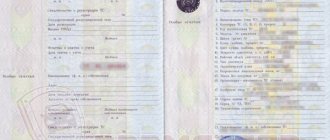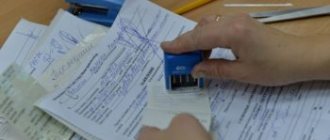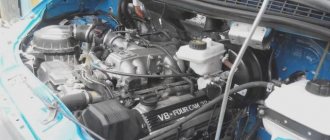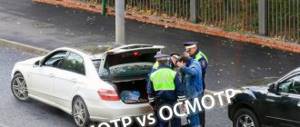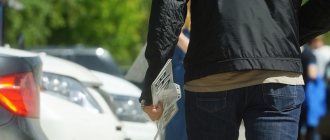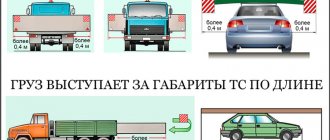What information does the PTS contain?
A vehicle passport is the main document of a car, containing detailed information about it. The passport is issued on a special strict reporting form and has a certain degree of protection in the form of special watermarks, holographic stickers and inscriptions.
The passport form is a sheet of A4 format, folded in half. The right side of the passport contains detailed information about the car. This part is filled out by a traffic police officer, vehicle manufacturer or customs service.
This part of the passport has 24 points with data:
- model, make of car;
- the country where the car was produced;
- car release date;
- body type;
- identification number (VIN code);
- name and details of the organization that prepared and issued the document.
The left half is divided into two parts. They contain information about all owners of the vehicle. The reverse side consists of four parts, also intended for entering data about the owners of the car. Thus, the maximum number of owners who can be entered on one form is 6.
You can see what a blank PTS form or a correctly executed document looks like in a photo on the Internet.
What is a duplicate
A duplicate of a vehicle passport, or simply PTS, is an official document. This is not some kind of copy made on a regular printer, supplemented with a seal or certified by the signature of a responsible person.
The duplicate has the same power as the original. It is issued in cases where, for one reason or another, the original document is lost or cannot be used in the future. At the same time, an important feature of a duplicate is the presence of reasons for its issuance and the inclusion of information from the original document.
To obtain it, you need to contact the traffic police department. Only this authorized body has the right to issue a copy of the original vehicle registration certificate.
Contents and external features
A vehicle passport belongs to the category of strict reporting documents. Its production is carried out exclusively by Goznak, having all the necessary certificates, permits and specialized equipment. Use blue paper to print originals.
But a duplicate is also considered an equivalent official document. But its distinctive feature is the presence of entries in a column intended for special marks. It is there that information is entered that this paper is a duplicate, which was issued in replacement of the old original document. Additionally, the details provided on the previous form are entered there.
As in the case of the first form issued to the motorist, the repeated document has 24 columns where all information about the vehicle is recorded. Namely:
- VIN code;
- car model;
- car body type;
- year of issue;
- engine information;
- vehicle weight;
- manufacturer country;
- details of the organization that issued the PTS;
- information about the owner.
Very often, especially recently, when selling problem cars, fake vehicle passports are used. Because of this, buyers should be extremely careful to distinguish between a fake and an original.
There are very high-quality fakes that only professionals can distinguish. But there are some features with the help of which even a beginner in this matter can determine the difference. It is recommended to constantly remember these nuances in order to avoid mistakes when purchasing a new vehicle.
There are 3 main features to remember:
- On top of the form that was issued instead of the original, the word DUPLICATE is always written in large letters.
- Each form is equipped with special security elements in the form of three-dimensional letters and watermarks. Their absence or weak expression clearly indicates a fake.
- It is unlikely that the documents that belong to a used car can be in perfect condition, as if it were a new car. If you see perfectly straight PTS, although the car itself is already more than 5 - 10 years old, there is clearly something wrong.
If here you have doubts about the authenticity of the document, it is better to seek help from professional experts. They will conduct an analysis and be able to say for sure whether it is a fake or an original copy issued in accordance with all the rules.
What is the difference between an original PTS and a duplicate?
In certain situations, restoration or replacement of the registration certificate is required.
If the original is lost or damaged, as well as if the personal data of the car owner changes, a duplicate PTS is issued. This document is issued at the traffic police department upon presentation of a package of documents. The purpose of issuing a duplicate is to replace the original. This paper completely repeats the main content of the technical passport and has its own details. So what is the difference between a duplicate PTS and the original?
The main difference between this document and the original is the presence in the upper left part, in the “Special about. This paragraph also states the basis for issuing a copy and indicates that the registration certificate has been re-issued.
What does a car title look like?
This registration certificate is made on a blue form measuring 20 by 31 cm. If you have ever held a diploma supplement or a marriage certificate in your hands, you will recognize the thick paper from which it is made.
The pages have RUS watermarks, a security stripe, microtext, three-dimensional drawing and a hologram (see photo of the car PTS above). The latter on the documents of the new type (after 2008) is round, with a car depicted inside. On old documents it is made in the form of a broken strip.
Look at the photo to see what a vehicle's PTS with an intermittent hologram looks like:
In what cases is a duplicate PTS issued?
The grounds for issuing it are few.
There are only a few reasons allowed for the re-issuance of PTS:
- loss of PTS;
- damage to a document;
- All lines on the PTS form are filled in, and there is no way to enter the new owner of the car.
Also, a duplicate PTS is issued to the car owner due to the need to make changes.
They are necessary to increase the relevance of information and concern only three points:
- Place of registration of the owner of the vehicle.
- Personal information of the car owner.
- Information about the vehicle.
These situations are not formal grounds for issuing a duplicate. But experienced motorists in such cases advise the owner to make changes to the current title.
Grounds for issuing a duplicate PTS
If a new vehicle is purchased, a passport is issued by the manufacturer. The buyer will receive the original from the hands of a car dealership employee. Buying a used car comes with the risk of getting a copy. There are several legal grounds for issuing an official copy:
- changing the personal data of the motorist or his place of registration;
- lack of lines for writing information about the new owner of the car;
- loss of the original form or its unusability due to damage.
If the vehicle is pledged to a banking institution, the car owner can issue a duplicate. The original in this situation is handed over to bank employees. A motorist can easily order a duplicate passport from the traffic police.
If such a car is sold, then with a high probability the buyer will soon lose it by a court decision.
The procedure for obtaining a duplicate PTS
You can receive a duplicate in 1 day. If additional checks are carried out, the registration period may increase to 30 days.
To re-receive a lost or replace a valid registration certificate, the following data is required:
- passport;
- documents confirming the purchase of the vehicle;
- certificate confirming ownership of the vehicle;
- explanatory note (if lost);
- MTPL insurance policy;
- receipt of payment of state duty.
After providing all the necessary information to the MREO, you need to go through the vehicle inspection procedure. If the registration certificate is lost, the inspector will inspect the car and sign the application. All documents are handed over to the traffic police officer.
What is a genuine PTS?
The original PTS is one of the main documents that allows you to identify the car .
So how can you find out whether a passport is real or not, how to distinguish it from a fake and check its authenticity? The form and regulations for filling out are fully described in Orders of the Ministry of Internal Affairs of the Russian Federation No. 496, the Ministry of Economic Development of the Russian Federation No. 134 (as amended on November 11, 2015), the Ministry of Industry and Energy of the Russian Federation No. 192 “On approval of the Regulations on PTS and vehicle chassis passports.” The term of this prescriptive document ends on July 1, 2017, when the Procedure for the functioning of electronic passports, adopted by federal decree No. 156-FZ of June 2, 2016, comes into force.
Important! If the PTS is lost, a copy is issued by the territorial divisions of the State Traffic Safety Inspectorate, and if the design of the vehicle is changed or re-equipped, the certification institutions are engaged in the production of the registration certificate.
When assembling a car at any domestic plant, a registration certificate is issued by the manufacturer. For foreign cars, it is envisaged that the PTS will be filled out at the customs post, after paying mandatory duties/fees and checking the “cleanliness” of the car.
How to distinguish a fake from the original
Unscrupulous sellers, for the purpose of deception, use a fake vehicle passport.
Modern fakes are practically no different from the original. How can a simple car owner, using available means, distinguish a real document from a “fake” paper? To examine the document you will need an ordinary flashlight and a magnifying glass. What should you pay attention to?
- First of all, you need to pay attention to the originality of the document.
- If the car seller has a duplicate on hand, you need to find out why it was issued.
- The vehicle passport is issued on a blue form measuring 20x31, which is printed on special paper. It feels denser to the touch, differs significantly from a simple one and looks more like a banknote.
- The RUS watermarks and stars should be visible in the light of the document.
- The hologram must have clear boundaries.
- The signature “PTS” should be located above the hologram in the corner. You can see it in the upper left corner by tilting the document about 30 degrees and highlighting it with a flashlight.
Upon detailed inspection of the document with a magnifying glass, you can see the special inscription “vehicle passport”. It is located on the line of the inner fold and forms a dark unbroken stripe.
The main inscription: “Vehicle Passport” sticks out a little. This can be felt by palpation.
The date of production of the form is indicated in the left corner of the bottom of the form. If the form was produced much earlier than the PTS was issued, then this is a fake.
What to be afraid of when buying a car with a duplicate title
If the buyer is going to buy a car with a non-original title, he should make sure that the seller is not a fraudster.
There are several fraudulent schemes in the modern market for buying and selling used cars. One of the most popular is the sale of credit cars. Criminals buy a vehicle on credit secured by a title. Next, they contact the traffic police department with a request to restore the lost vehicle passport. And based on the legal owner, a duplicate is made in the name of the fraudster. He sells the loan car, thereby transferring all loan obligations to the new owner.
The second way to deceive buyers is to sell a car that is the subject of property disputes. In this case, the original PTS is in the possession of one person, and the car is in the possession of another. The fraudster contacts the traffic police, receives a non-original document and sells the car on the secondary market. Even after the sale of the vehicle, it does not cease to be the object of a property dispute, therefore, after the trial, the new owner will have to give the car back, even if he is a bona fide purchaser. In 98% of cases, the court sides with the real owner of the car.
What should you be wary of?
You need to be careful when buying a used car.
When checking the original passport or its copy before concluding a contract, you should also pay attention to these signs:
- too many previous car owners;
- car ownership periods are too short;
- remote registration region;
- the seller is in a hurry and nervous, rushing to conclude a deal as quickly as possible;
- undervalued car;
- The document is too neat, looks like it was reprinted.
If, when checking the document, at least one of the points was identified, there is no need to immediately refuse the purchase. It just takes more time to check the car owner's documents.
PTS: differences between the original and the duplicate
Selling a car does not currently require deregistration with the traffic police. This circumstance places the responsibility for checking the documentation on the buyer of the car. The simplified procedure for selling cars opens up wide opportunities for the use of fraudulent schemes. Therefore, you should take a responsible approach to checking documentation.
A duplicate PTS can be distinguished from the original by the following features:
- The presence of the “Duplicate” stamp in the block of special marks.
- The official copy, like the original PTS, must have protection: a hologram, watermarks, three-dimensional letters.
- When buying a used car, you should pay attention to the appearance of the paper. If the form is new, then the future car owner should be wary. The original form, unlike the duplicate, during use takes on a not very neat appearance, gets overwritten, and so on.
Attention to special marks
This section in the original form must be studied. It contains information about the car:
- registration procedure;
- participation in transport accidents resulting in serious damage;
- information about your previous passport;
- if the original contains a mark indicating payment of the recycling fee, then re-registering the vehicle will be problematic;
- Photos of the car can be pasted into the PTS, which is allowed for the procedure of removal and registration in the event of corrosive changes on the identification numbers.
To avoid the possibility of purchasing a vehicle pledged to a bank with false license plates, or to purchase a vehicle that is listed as stolen or is under criminal proceedings, you should carefully study and analyze the vehicle documents:
- If the PTS indicates too many previous owners of the car, then this should raise suspicion. This technique is used to confuse the buyer.
- If you are purchasing a foreign car, check the car document for the presence of customs marks. Their absence will limit the ability to operate the vehicle.
- You should refuse to purchase a car with a copy of your passport from a dealership with a controversial reputation.
- A fake PTS is often characterized by a distant subject of vehicle registration. If it is very far from the place of sale, then you should refrain from purchasing.
- A new car cannot be sold with an official copy.
- You should not purchase vehicles in perfect condition at a suspiciously low price. The seller's demand to transfer funds immediately and in full is a sign of fraud.
Where and how do you get duplicate PTS?
If the title for your car is damaged or lost, there is only one legal way to obtain a duplicate - contacting the traffic police. A duplicate may also be needed in the event that there is no more space left in the PTS to enter the new owner, as well as if the owner of the car has changed his passport details. The new document is issued within a few hours, and to receive it you need to present the car for which you are applying for examination for examination. You will need to take with you:
- your own passport or a substitute certificate;
- auto insurance policy;
- a document that indicates that you are the owner of the car (purchase agreement, deed of gift) or a power of attorney issued by the owner;
- old damaged PTS (if you have one);
- receipt of payment of the duty determined by the state.
In addition, you need to fill out an application form and write in any form an explanatory note about what happened to the original PTS and why you need a duplicate. If the car was stolen along with its documents, a police certificate will be added to the list stating that the investigation into the theft is closed.
The traffic police will carefully study the papers you submitted and check the VIN code on the car and in the documents. If the police officers do not have any additional questions, then you will be able to pick up the finished duplicate PTS on the same day, but theoretically the process could drag on for up to a month. Making a duplicate is a paid service, the cost of which is determined separately by each region.
If a traffic police officer refuses to issue a duplicate, demand that the reason for the refusal be presented to you in writing - you can then go to court with this document.
How to reduce the risk of trades with a copy?
First of all, it is worth noting that purchasing a vehicle using a duplicate vehicle passport is a transaction with increased risk . You need to understand what kind of risk you are exposed to:
Purchasing a vehicle with an outstanding loan agreement (threatens confiscation from the new owner in favor of the creditor by court decision in accordance with Federal Law 353 “On Consumer Lending”).- Acquisition by one of the owners of jointly acquired property . For example, during divorce proceedings and division of property, one of the spouses secretly sells a car from the other.
If you nevertheless decide to purchase a car with a duplicate passport, it is recommended that you first pay attention to whether the document contains records of previous owners other than the seller. If the title contains information only about the current owner, this is a reason to think about it.
Important! Suspicious duplicates can be considered those that were received not so long ago, relative to the day of sale (up to 3 months). A recent date of receipt of the duplicate can also serve as an indirect sign of the dealer’s dishonesty.
Reasons for receiving
Due to the fact that the duplicate has the same legal force as the original document, its use has no restrictions. There are more than enough reasons to ask the owner for a copy of the PTS:
Loss or theft of the original.- Replacing the title due to the lack of fields for entering data about the new owner.
- Issuing a duplicate on a new form to replace the worn one.
The reason for replacing the duplicate should be reflected in the “Special notes” field, indicating the series and number of the previous document. The loss of a document is the most common pretext for obtaining a duplicate PTS for the purpose of committing criminal acts.
A vehicle passport is not a document that must be constantly carried with you and presented, for example, to traffic police officers, so it is quite difficult to lose it. As practice shows, buying a car with a duplicate title is a transaction with increased risk.
Video about duplicate PTS
Related publications
- What do red license plates mean on a car in Russia?
- What should be in a car first aid kit in 2021?
- Car curb weight: what is it?
- What is a Green Card for a car?
Leave a review
Cancel reply

